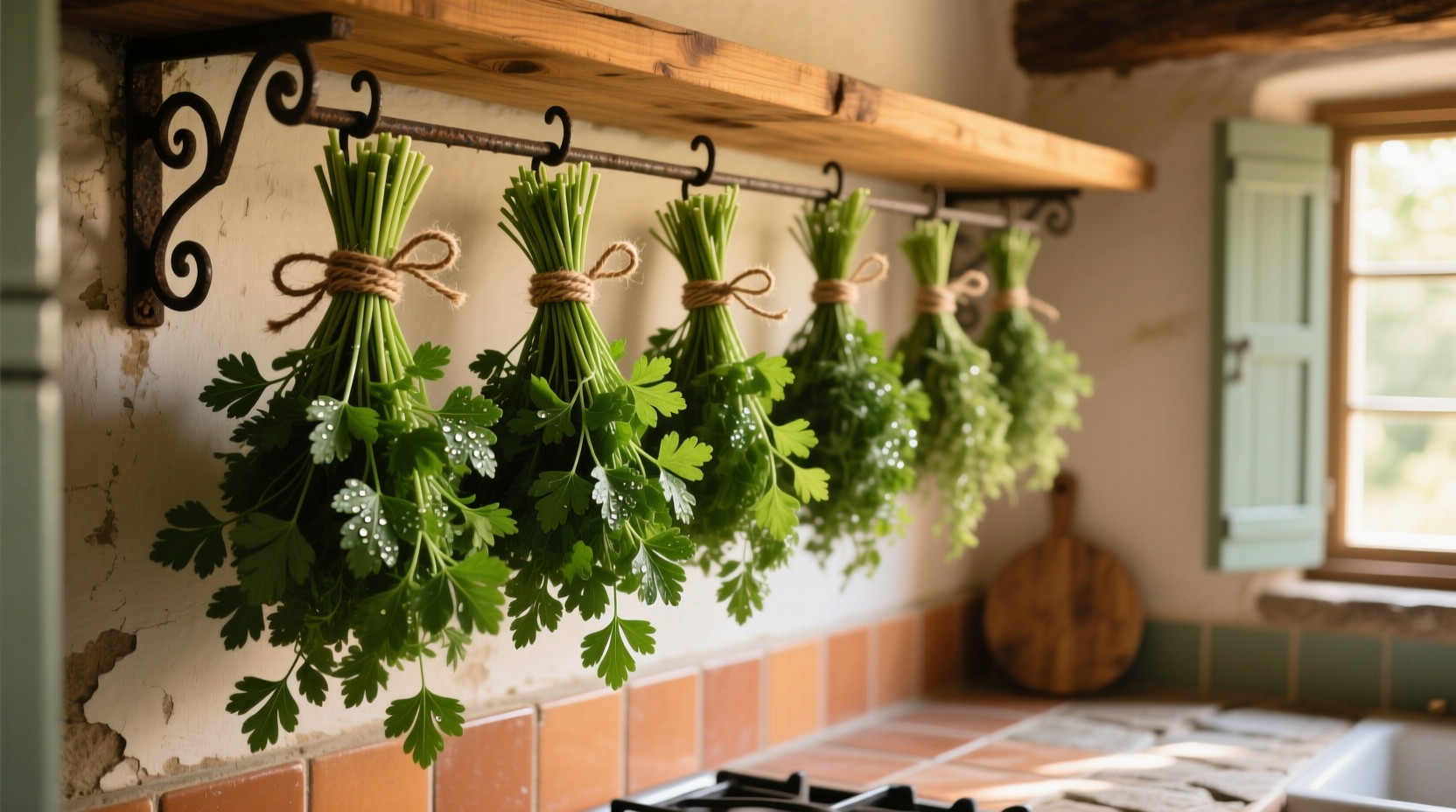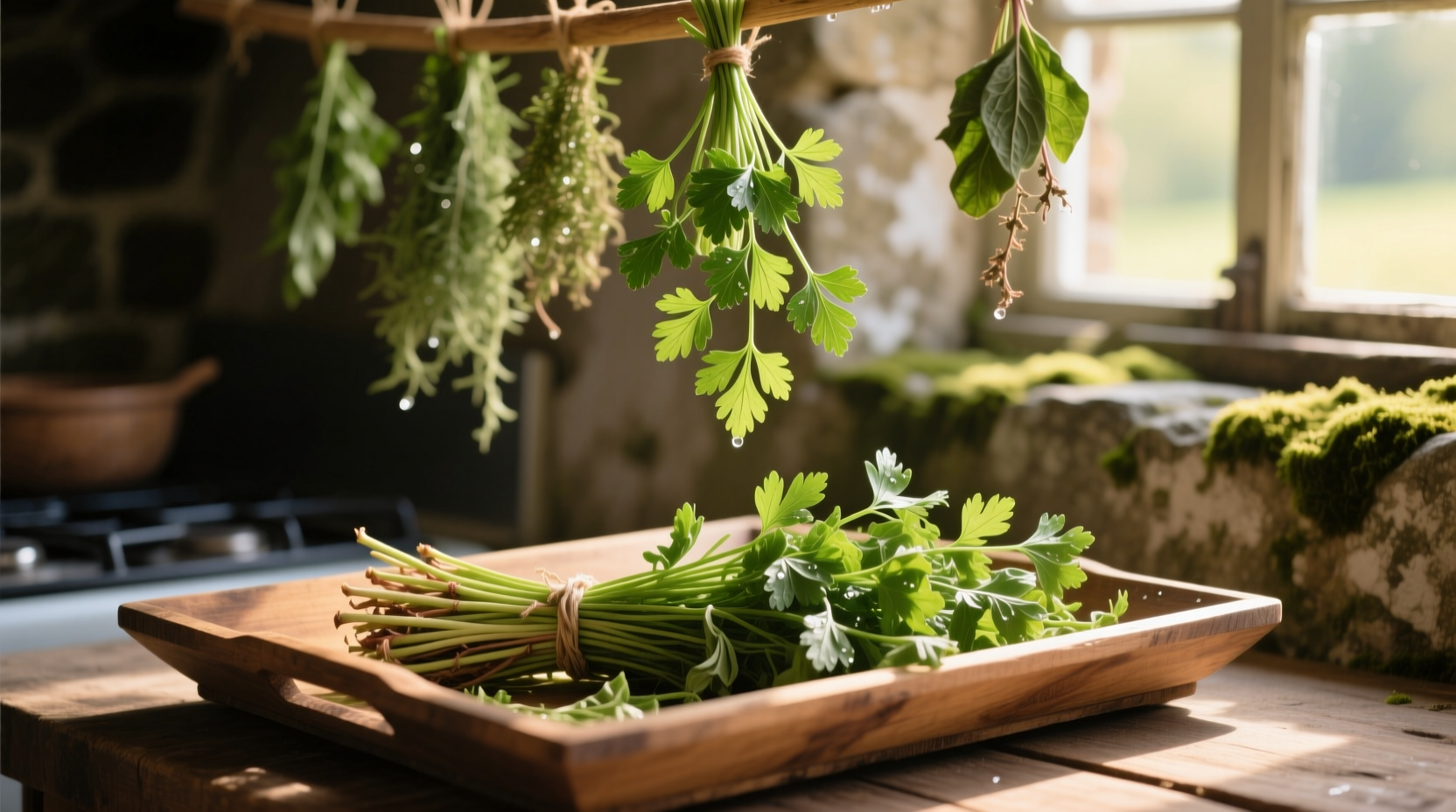Why Proper Parsley Drying Matters
Most home cooks lose 40-60% of parsley's flavor during drying due to improper techniques. According to USDA agricultural research, preserving parsley's volatile compounds requires careful temperature control. When dried correctly, parsley retains its nutritional value and distinctive fresh flavor profile, making it superior to store-bought dried versions that often lose potency during commercial processing.

Preparing Parsley for Drying: The Critical First Step
Harvest parsley in the morning after dew evaporates but before heat intensifies. Select stems with vibrant green leaves, avoiding yellowing or flowering plants. Gently rinse under cool water and shake off excess moisture – never soak herbs as this damages delicate oils. Pat dry with clean linen towels, then trim woody stems while leaving 2-3 inches for hanging. Professional chefs recommend removing thick stems that contain bitter compounds.
Drying Method Comparison: Which Works Best for You?
| Method | Time Required | Flavor Preservation | Best For |
|---|---|---|---|
| Air Drying | 1-2 weeks | 85-90% | Small batches, no equipment needed |
| Oven Drying | 2-4 hours | 75-80% | Urgent drying needs, humid climates |
| Dehydrator | 4-6 hours | 80-85% | Consistent results, multiple herb batches |
This comparison reflects data from University of Massachusetts Extension research on herb preservation. Air drying preserves the highest flavor percentage but requires ideal environmental conditions – 70-80°F with 40-60% humidity. Oven drying works faster but risks scorching delicate leaves if temperature exceeds 150°F. Dehydrators offer the best balance for most home cooks, maintaining consistent low heat without constant monitoring.
Air Drying Technique: Traditional Method Done Right
Bundle 5-6 stems together with twine, ensuring leaves don't touch. Hang upside down in a dark, well-ventilated space away from direct sunlight. The drying timeline follows three critical stages: 24-48 hours for initial moisture loss, 3-7 days for structural drying, and 7-14 days for complete dehydration. Check daily by rubbing a leaf – it should crumble easily when properly dried. Avoid humid rooms as moisture causes mold; ideal conditions maintain 40-60% relative humidity.
Oven Drying: When Time Is Limited
Preheat your oven to its lowest setting (140-150°F). Spread leaves in a single layer on parchment-lined baking sheets. Prop the oven door open 2-3 inches using a wooden spoon to allow moisture escape. Rotate trays every 30 minutes for even drying. Total drying time ranges from 2-4 hours depending on oven accuracy and humidity levels. The key indicator is when leaves turn brittle and crumble easily between fingers. Never exceed 170°F as higher temperatures destroy volatile flavor compounds.
Dehydrator Settings for Optimal Results
Set your dehydrator to 95°F for parsley. Arrange leaves in a single layer without overlapping on trays. Check after 4 hours – most batches finish in 4-6 hours. The critical moisture threshold is 10-12% water content, which professional dehydrators can measure with built-in sensors. Without sensors, test by crushing a leaf; it should break cleanly without bending. Rotate trays hourly for consistent results, especially in stackable dehydrators.
Storage Secrets for Maximum Shelf Life
Store completely cooled dried parsley in airtight glass containers away from light and heat. According to FDA food storage guidelines, moisture content below 12% prevents mold growth. Add silica gel packets to absorb residual moisture in humid climates. Properly stored dried parsley maintains peak flavor for 6-12 months – significantly longer than commercial products that often degrade within 3-4 months due to improper initial drying.
Using Dried Parsley: Flavor Conversion Guide
Understand the dried-to-fresh conversion ratio: 1 teaspoon dried parsley equals 1 tablespoon fresh. Rehydrate leaves in warm water for 10 minutes before using in salads or cold dishes. For cooked applications, add dried parsley early in the cooking process to allow flavor release. Note that dried parsley develops a more earthy, concentrated flavor compared to fresh's bright notes – adjust recipes accordingly. Professional chefs recommend using dried parsley in soups, stews, and tomato-based sauces where its robust flavor shines.
Avoid These Common Drying Mistakes
- Washing right before drying – Always dry herbs thoroughly before the drying process begins
- Overcrowding bundles – Prevents proper air circulation and causes mold
- Using high heat – Temperatures above 170°F destroy essential oils
- Storing while warm – Traps moisture leading to spoilage
- Using plastic containers – Glass provides better moisture protection
Frequently Asked Questions
How can I tell when parsley is completely dried?
Properly dried parsley should crumble easily between your fingers with no moisture visible. When bent, the stems should snap cleanly rather than bend. The color should remain vibrant green without dark spots, which indicate mold from incomplete drying.
Can I dry parsley in the microwave?
While possible, microwave drying often produces inconsistent results with scorched edges and uneven drying. If using this method, place leaves between paper towels and microwave at 10% power for 30-second intervals, checking frequently. Most culinary experts recommend traditional methods for better flavor preservation.
Why does my dried parsley turn brown instead of staying green?
Browning occurs from excessive heat exposure or improper drying conditions. University of California food science research shows chlorophyll degrades above 140°F. To maintain green color, dry at temperatures below 100°F in darkness, as light exposure also breaks down pigments.
How much fresh parsley do I need to make one tablespoon of dried?
You'll need approximately 3 tablespoons of fresh parsley to yield 1 tablespoon of dried. This 3:1 ratio accounts for moisture loss during drying. Measure after complete drying and crumbling for accurate conversion in recipes.
Can I freeze-dry parsley at home?
Home freeze-drying requires specialized equipment, but you can approximate the process by freezing small bundles on a tray before transferring to airtight containers. While not true freeze-drying, this method preserves more volatile compounds than traditional drying, maintaining up to 95% of original flavor according to Cornell University food preservation studies.











 浙公网安备
33010002000092号
浙公网安备
33010002000092号 浙B2-20120091-4
浙B2-20120091-4